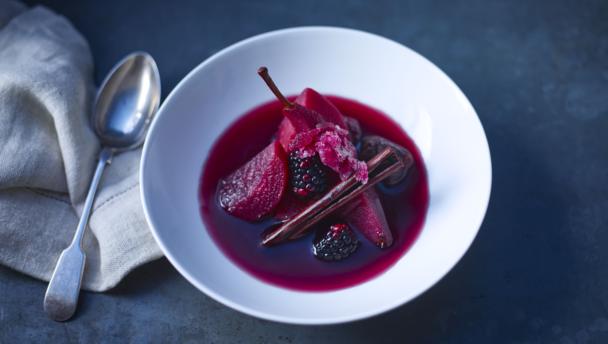
This dessert defines an exact moment in the season – the end of autumn and the beginning of winter – and I prepare it as soon as the first quince are ripe. However, with its warm and spicy flavours it is also a lovely prelude to Christmas.
Each serving provides 226kcal, 9g protein, 26g carbohydrate (of which 18.5g sugars), 0.5g fat (of which 0.1g saturates), 5g fibre and 0g salt.

For the red wine jus, in a saucepan over a high heat, bring the red wine to the boil for 2 minutes, which will remove much of the alcohol, then add 400ml/14fl oz water and the remaining jus ingredients and bring to a gentle simmer.
For the winter fruit, poach the quince in the simmering jus for around 25 minutes. Add the apples and pears and simmer for 4 minutes. Leave to cool to room temperature before adding the prunes and blackberries (if using). Strain a third of the liquor and freeze overnight; cover and chill the remaining liquid and fruit in the fridge.
To serve, scrape the frozen cooking liquor with a fork to create beautiful flakes of perfumed ice. Arrange the fruit, spices and cooking juices in a large dish or divide between four bowls. At the last moment, put a spoonful of the delicate flakes of spiced wine granita on top of your dessert. You could alternatively serve the granita in small cups from the freezer as a little pre-dessert.
Tip 1: I normally use vanilla purée, but here I want the vanilla to diffuse its flavour slowly so as to penetrate the quince, and the most effective means of achieving this is to use a pod.
Tip 2: My general rule about wine when cooking is not to use an expensive bottle. Look for a deep, rich-coloured Cabernet Sauvignon or Merlot. Pinot Noir is too light.
Tip 3: It is important that the liquid does not boil while poaching the fruits, as the intensity of the heat will damage their delicate flesh.

By Michel Roux Jr.
See more quince recipes (20)

Kew on a Plate
4. Winter
BBC Two
Recipes from this episode